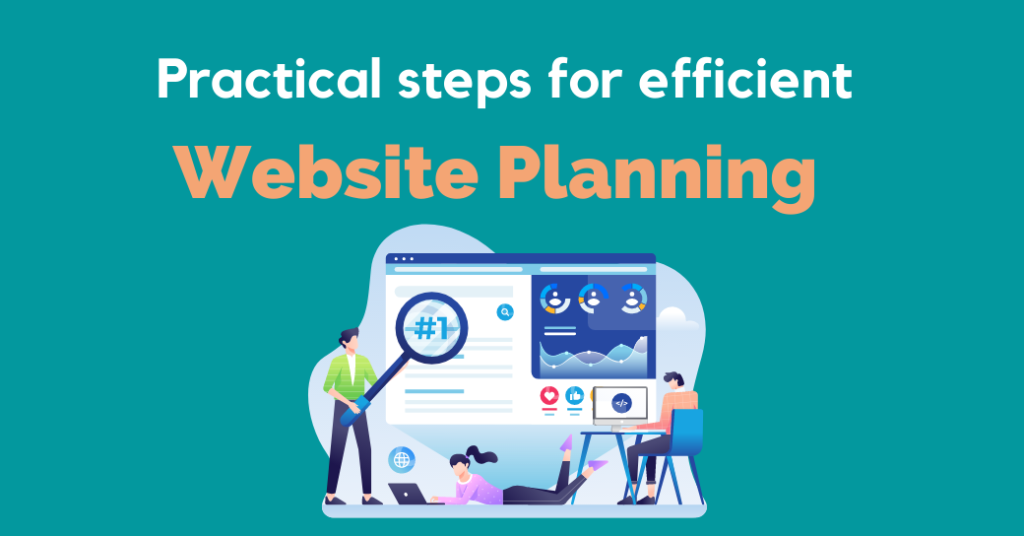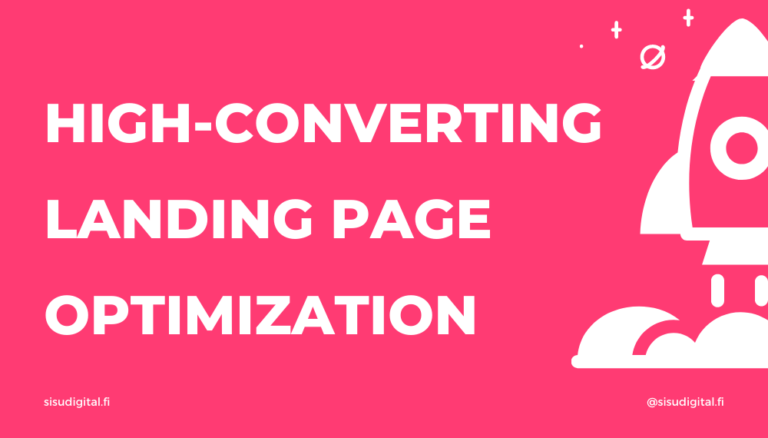Website planning is often confused with web design planning. But the two concepts are entirely different. Website planning is creating a blueprint for your entire website creation process. A web design process is often a subset of a website planning process.
Website planning includes everything that happens after the thought “my business needs a website” forms in your mind and before you begin building your website. And, a lot happens in between that needs to be planned right to ensure that your website is in alignment with your business goals.
Whether you are building a 1-page website or a multi-page complex website, the website planning is crucial for success. Website planning is also important whether you are building a brand-new website or redesigning your old website.
Why Go for Website Planning?
Often, website planning takes a backseat or is ignored altogether, either due to a lack of awareness regarding its benefits or because of pressure from stakeholders. But website planning can help you create an effective roadmap, defining each significant element essential for successful website creation.
A website plan essentially deals with the “why”, “what” and “how” of your website creation. Planning helps you understand:
- “Why” do you want a website for your business?
- “What” kind of website your business would benefit from?
- “How” do you want your website to be?
If you are a marketer wondering how investing in website planning can help your business, then here are some advantages you need to consider:
- Build a successful website
- Reduce expenses caused due to:
- A need for constant revisions.
- Absence of important website features.
- Incompatibility between content and design.
- Failure of the agency to complete the website within the deadline.
- Postponement of website launch because of a lack of alignment between website visualization and results.
- Failure of the website to achieve intended goals such as traffic and conversions.
- Reduce the risk of project failure enormously.
- Prevent errors in the new website in case you are redesigning your old website. Planning enables you to examine the flaws of your current website and ensures that the mistakes are not carried over to the newer version.
- Choose your web agency based on clear-cut parameters rather than rushing into a decision and regretting it later.
- Choose the right web-building partner that stays with you as you scale your business.
- Finish your website creation project faster than you expected and with more success rate.
- Be happier and confident with a successful website.
Steps to Plan your New Website

A website planning process consists of concrete steps. These steps tell business owners, website designers, and developers, and marketers, what they have to do, and how to go about the process. Here are the steps involved in a website plan:
1. Clear Business Goals
What business goals do you want your website to achieve? The answer to this question will help you decide the theme, features, and presentation of your website. Use of the S.M.A.R.T. approach for defining your business goals ensures clarity of the goals. This approach also ensures that the goals are convertible into tangible website parameters.
As an example, say your business goal for the website is to increase leads. This is a generic goal.
Let us see how S.M.A.R.T. approach makes this goal more achievement-friendly:
- S – Specific – How much increase in leads are you expecting? Say, you want a 10% increase in leads.
- M – Measurable – How do you know if the goal has been reached? You can include features such as analytics to know if your website is bringing in intended leads.
- A – Achievable – Is your goal practically feasible? What is the cost being invested per lead to achieve the intended 10% increase in leads? Is it viable for your business?
- R – Relevant – If your goal is achievable, then it is relevant. An impractical goal demotivates your team. A relevant goal encourages teams to come up with creative ideas to achieve it.
- T – Time Bound – A goal without a realistic deadline is a shot in the dark. What is the timeline you would assign for your goal?
2. Creating a Strategy Curve

A strategy curve gives you the key elements that you need to focus on before you start creating your website. For your strategy curve to be successful, include the following elements:
Customer Needs – The primary objective of your website is to attract and engage customers. So, you must consider their needs before, not after or while, creating your website.
Doing market research and surveying existing customers are some best ways to find out what your customers expect from your website. Identify the kind of information and the type of design (e.g., colors, visuals, content structure, etc.) your customers are interested in, through your research.
Customer Profiles or Buyer Personas –Customer profiles or buyer personas can help you understand your target audience better. You will get to know them on a deeper level, such as knowing their demographic details, interests, pain points, and preferred buying methods.
These invaluable insights help you plan website elements (e.g., features, content, visuals, etc.) more efficiently. With well-researched buyer personas, you can create a website that specifically targets your prospective audience.
Profiles also minimize the risk of attracting the wrong target customers. A website that meets the needs of your target audience exactly reduces additional efforts on marketing, sales, and website optimization. As a result, you can save time, costs, and resources.
Company Profile – A well-presented company profile is important to generate credibility and earn visitor trust. Your company profile must include:
- Products and Services – Decide the product and service range that you want to present on your website.
- Market Insights – Often, your market situation can help identify opportunities that you can use online. It could be a product feature, a service add-on, a specific demographic reach, or other insight. You can discover untapped opportunities through thorough research.
- Competition – Researching your competitor is key to planning your website in a way that you can be ahead of them online. Competitor analysis allows you to identify mistakes that you would want to prevent on your website. This opportunity equips you with a competitive advantage.
- Competitive Advantage – Explain specifically how you are creating value for your customers in a way that your competitors are not.
3. Sitemap Creation
A sitemap serves as a foundation for any website. It tells all parties involved in the website creation process about the route map involved. It typically tells how information flows across your website and how pages will be interlinked.
A well-defined sitemap makes work easier for website designers and developers, and content strategists. You may not be entirely aware of information flow at the time of website planning. But you can create an approximate guideline. For example, you can create labels such as web pages, forms, videos, live feeds, and blog posts, and sequence them.
4. Content Creation
Content is a crucial aspect of your website. Content is important because it engages your target audience and boosts your SEO (Search Engine Optimization) efforts too. Both these elements are crucial to get your visitors to take the next action and convert into leads, prospective customers, and buyers.
So, planning for content creation before moving to website creation is important. Sitemap creation should give you a rough idea of the extent of content that you will have to create. This will help you create a content plan.
Be specific when creating a content plan. For example, if your website includes blog posts, then specify how many blog posts you would like to publish and mention the frequency of posting. If you are offering an e-book or a report, then mention the limit on customer downloads for such content.
Take into account your marketing goals as well because you want your content to deliver on these goals too. For example, if your marketing goal is to generate leads, then you could include a Call-to-Action in your content that directs customers to a form asking for their details.
5. Wireframe Creation

Once you have a basic content strategy in place, the next step is to define a flow for the content. Creating content flow gives you a clear picture of where your content is headed and if it is the path you visualized. Besides, content flow gives you an insight into how good a content experience you can create for your visitors.
A wireframe is a tool that helps you define your content flow. A wireframe is similar to a blueprint created by architects for their projects. Wireframes can be developed by hand or drawn digitally.
A well-developed wireframe serves as a clear overview of every webpage. It includes details of page layout, content placement, content function, and users’ content navigation points.
Developing a wireframe delivers 3 key benefits:
· A wireframe gives you a clear understanding of what goes into your webpage. It will specify the element of each space. For example, you will understand where a call-to-action will be placed and where a hero image would be introduced.
With such detailed specifications, a wireframe will inform stakeholders of the amount of space they will have to work with, on a webpage.
A wireframe helps you view the webpage with all its features embedded. This is the right stage to identify elements that do not fit in with the rest of the features on a page and remove them.
· A wireframe facilitates better communication among project stakeholders, including website owners, designers and developers, and content creators. It helps stakeholders to brainstorm and come up with more user-friendly ideas.
Arranging for user testing during the initial stage of wireframing helps gain greater clarity on user requirements. A wireframe enables you to understand how users will interact with your interface.
Guided by your wireframe, you can create a website that is easy to navigate and understand, for your customers.
· Wireframes are easy and cheaper to create. Handmade wireframes cost you stationery. Digital wireframes are simpler to create and can be completed within minutes.
There are low-fidelity wireframes, which are rough skeletal representations of a webpage. They include simplistic images, space-holder content, and block shapes. As they are only rough sketches, pixel accuracy or clear shapes cannot be expected from low-fidelity wireframes.
Mid-fidelity wireframes are more accurate than low-fidelity wireframes. They are usually black & white in representation. But different shades of gray may be used to indicate the prominence of elements on the webpage.
Content elements such as headings and body are represented in varying degrees of prominence to specify the inherent difference. These wireframes specify all webpage features in a more detailed way than low-fidelity wireframes.
High-fidelity wireframes are highly specific and pixel-accurate. These wireframes include real images (not fillers as in other wireframe types) and relevant content to lend greater clarity to the specifics of the webpage.
As high-fidelity wireframes are detailed in representation, they are used to represent features such as complex menu systems and interactive elements such as maps.
6. Visualization of Visual Elements
This is the stage where you plan the actual look of your website. Decisions on the brand elements such as logos, colors, and images, are decided during this stage.
An eye-catching design with only elements that serve a purpose is usually encouraged by experienced planners and designers. While images are important, their inclusion without a purpose can result in wasted efforts and a poor user experience.
7. Put an Approval Process in Place
A website project, by its nature, involves various stakeholders. There are bound to be multiple ideas, works, and reworks, which is why having an approval process is crucial. Even if you are working with an outside agency, having an approval process in place helps reach a final decision without confusion.
Create an approval process hierarchy so that stakeholders know the authority that makes the final decision. In case of involvement of an outside agency, have a written document of the workflow and obtain an agreement from the agency. This ensures a smoother process flow.
8. Timelines

Timelines are important to help the team plan their tasks, set targets, and achieve them. Realistic timelines motivate the team to focus on set targets and achieve them.
Plan timelines for project milestones. Your timelines should include the period of initiation of the project, frequency of tasks, number of milestones, and proposed deadlines for each milestone.
9. Budget and Resources
Analyze your resources and assign responsibilities before the initiation of a project. This ensures constant resource availability and prevents delayed execution, which in turn can delay your website launch. If you are working with an agency, ensure that you coordinate with them as and when needed. Assign a representative to take your place when needed.
Budgeting beforehand will give you clarity on project spending areas, repeat spending, one-time costs, and maintenance costs. Budget planning also ensures that you do not leave out any spending area, which poses the risk of your project getting halted midway.
There are many aspects to website creation, including design & development, domain registration, hosting, and maintenance. Obtain clarity from your agency regarding the future costs that you would have to incur. Remember that design changes attract hefty fees, which is why planning beforehand is crucial.
In Conclusion
Website planning is as important as planning for other aspects of your business. With a well-developed website plan, you can build a website that makes your vision a reality, delivers tangible and intangible benefits in the long run.
If you are ready to plan your website, then contact us. Our WordPress web design service can help you with different options for your WordPress website planning. We can guide you from website planning through launch. Learn more about what we can offer.







